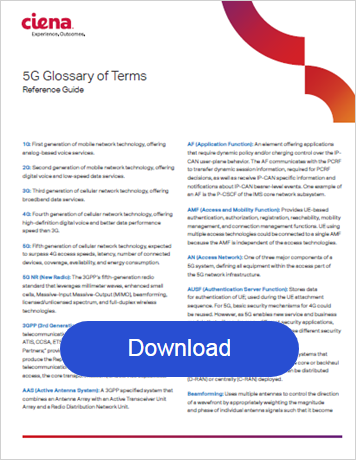10 new terms that will help define the future of 5G
Trying to digest the vast amounts of information related to 5G is like drinking from a fire hydrant, and it doesn’t help that there is a litany of new terms being introduced as part of the journey to 5G architectures.
Below is just a sample of the 5G terms making their way through the industry. To get a full handle on all the 5G lingo, download our 5G Glossary of Terms eBook that defines 60+ total terms and acronyms related to the 5G industry.
 And to get a complete view of the technologies and trends that are driving the
move to 5G, make sure you read our entire 5G Boot Camp series for
blog posts.
And to get a complete view of the technologies and trends that are driving the
move to 5G, make sure you read our entire 5G Boot Camp series for
blog posts.
3GPP (3rd Generation Partnership Project): A group of seven telecommunications standard development organizations (ARIB, ATIS, CCSA, ETSI, TSDSI, TTA, TTC) known as “Organizational Partners” that provides its members with a stable environment to produce the reports and specifications that define cellular telecommunications network technologies, including radio access, the core transport network, and service capabilities.
5G NR (New Radio): The 3GPP’s fifth-generation radio standard that leverages millimeter waves, enhanced small cells, Massive-Input Massive-Output (MIMO), beamforming, licensed/unlicensed spectrum, and full-duplex wireless technologies.
CPRI (Common Public Radio Interface): Is a digitized and serial internal radio base station interface that establishes a connection between Radio Equipment Controller (REC), commonly known as Baseband Units (BBU), to the Radio Equipment (RE), commonly known as Remote Radio Heads (RRH), via single-hop and multi-hop topologies.
EN-DC: E-UTRA (LTE) to NR Dual Connectivity. An architecture where both LTE eNodeB and NR gNB will be co-deployed, allowing the user equipment to simultaneously establish two radio bearers, each to the respective NodeBs.
Fronthaul: Defines the network segment connecting 3GPP Distributed Units (DUs) to Centralized Units (CUs) in a Centralized Radio Access Network (C-RAN) architecture. Fronthaul is further sub-categorized as Fronthaul HLS and Fronthaul LLS.
M-CORD (Mobile-CORD): Focuses on a fully disaggregated and virtualized RAN and mobile core using open source collaboration, bringing the value of data center economics and cloud agility.
MIMO (Multiple-Input Multiple-Output): Allows sending and receiving of more than one data signal on the same channel at the same time by using more than one antenna, thus improving the data rates between the transmitter and the receiver.
mmWave (millimeter wave): High-frequency waves (microwaves) in the millimeter band; considered to deliver faster, higher-capacity 5G services.
Network Slicing: Virtual slices of a physical network supporting specific performance guarantees.
Small Cell: Low-powered cellular radio access nodes that operate in licensed and unlicensed spectrum, serving fewer users at high access speeds over a small geographic area.
This list is just a drop in the bucket. For a full glossary of definitions for over sixty 5G-related terms and acronyms, download our 5G Glossary of Terms eBook.
Have questions or comments on our 5G definitions? Let us know in the comments box below.








